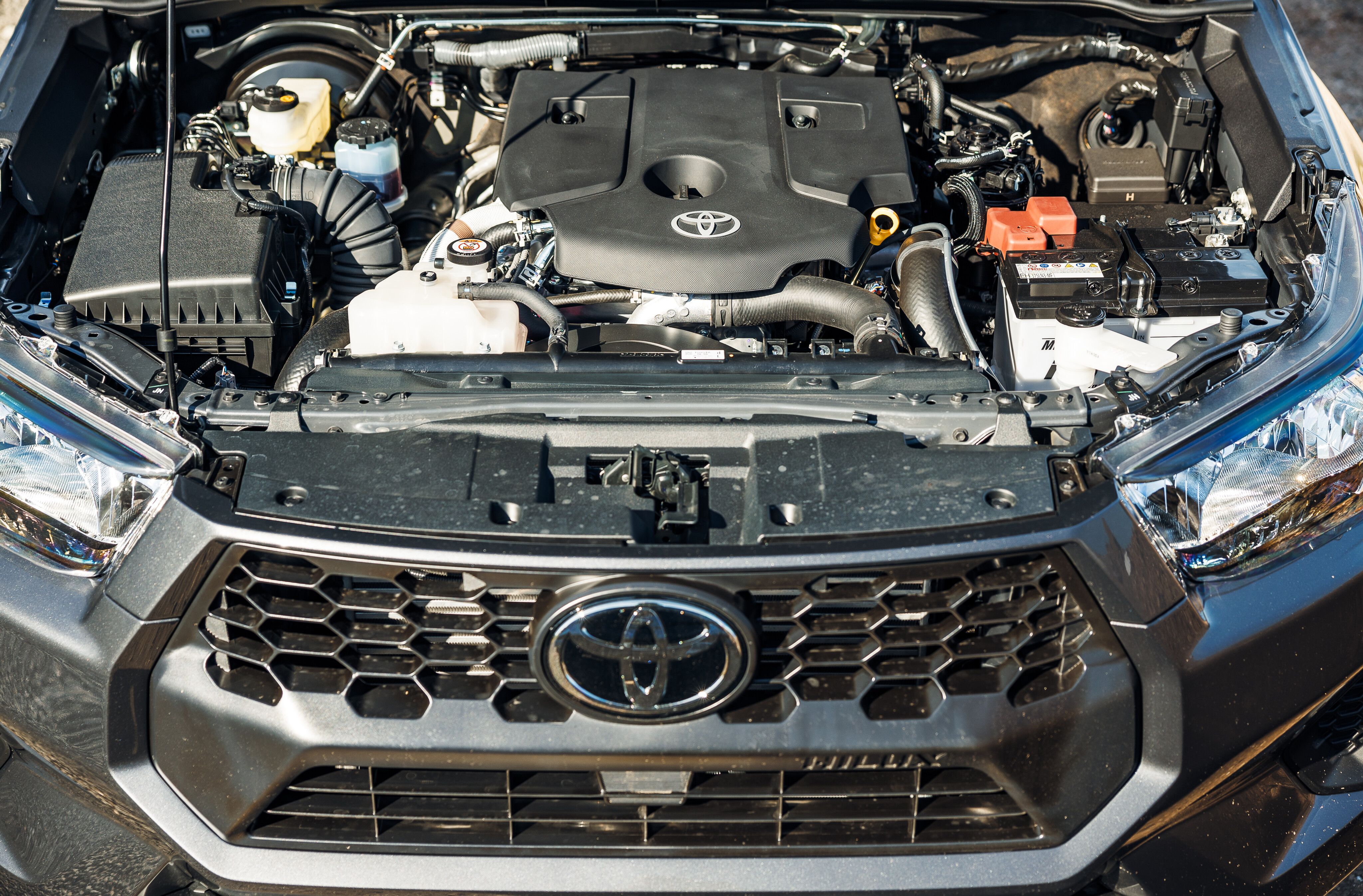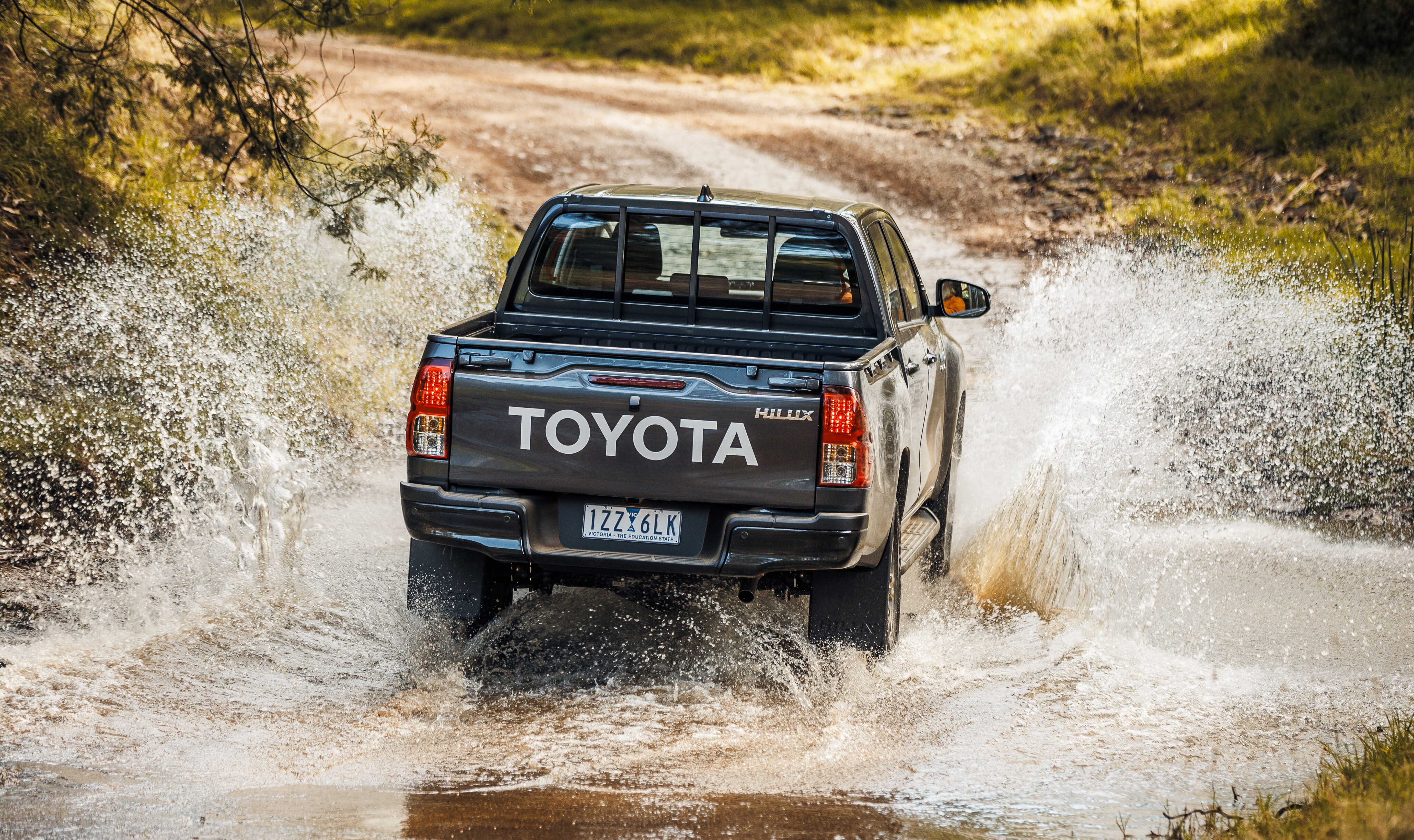
Things we like
- Fuel improvements
- Excels off-road
- Remains tough
Not so much
- Dated interior
- Harsh on-road ride quality
- Hard to truly gauge the 48V low-speed improvements
The HiLux may be getting a tad long in the tooth in the dual-cab game, but with Toyota still selling its venerable dual-cab in large quantities on a monthly basis – second behind the Ford Ranger on the 4x4 charts in April 2024 – the bean-counters at HQ don’t seem to be hell bent on hurrying a next-generation model out the showroom door.
Instead, the iconic brand has refreshed its near-ten-year-old vehicle in 2024 by adding a 48-volt mild hybrid system dubbed V-Active technology. Interestingly, it’s the first such hybrid system to feature in a dual-cab ute in Australia.
Said technology is standard on the top-of-the-range Rogue model and is available as an option for SR (the model tested here) and SR5 double-cab 4x4 grades mated with the automatic transmission.
The nuts and bolts of it reveals that the system effectively pairs Toyota’s existing 2.8-litre turbo-diesel four-cylinder engine with a 48-volt battery, lithium battery, and motor generator which is attached to the engine by a dual-arm belt tensioner. The generator is mounted high in the engine bay so as not to hinder the vehicle’s 700mm wading depth, and it acts as a conduit by recovering energy when braking and decelerating and then feeding it into the 48V battery.
The point of all of it is to not only improve fuel efficiency and limit emissions, but also be of benefit in the day-to-day grind by providing a ‘smooth’ stop-start functionality. As a result, engine idle has reduced from 720rpm to 600rpm – plus Toyota says it’s added a ‘Long’ mode, which can leave the engine switched off as long as possible when parked up and using power, even with the air-con on.

Overall output of the 2.8-litre turbo-diesel four-pot remains at 150kW and 500Nm, despite these additions. However, a closer look reveals fuel efficiency has slightly improved, as one would expect. Toyota is on record as saying the technology provides a (roughly) 10 per cent benefit to fuel economy across the model range. As an example, this SR pick-up variant on test is listed at drinking 7.4L/100km, while the variant sans 48V tech registers 7.9L/100km.
The below table provided by Toyota demonstrates the difference.
| 1GD (L/100km) | 1GD 48V (L/100km) | |
|---|---|---|
| SR double cab-chassis 4x4 6AT | 8.4 | 7.6 |
| SR double-cab pick-up 4x4 6AT | 7.9 | 7.4 |
| SR5 double-cab chassis 4x4 6AT | 8.4 | 7.6 |
| SR5 double-cab pick-up 4x4 6AT | 7.9 | 7.2 |
| Rogue double-cab pick-up 4x4 6AT | 8.4 | 7.8 |
Does the 48V system have an overt impact, though? Well, yes and no. The HiLux is calmer when idling, smoother than any HiLux before it, and the stop/start system is polished in its operation.
Whether it’s quieter at idle is extremely hard to say without using a decibel meter. Whether the 48V system makes the vehicle more spritely at low revs is also difficult to discern. In all honesty it’s barely noticeable and most punters wouldn’t even feel the difference. A back-to-back drive of both variants could provide greater clarity, though, but we predict the differences would be marginal.

What the 48V system can’t help with – obviously – is the HiLux’s on-road ride quality, which remains very ‘past-gen’ – something you’re starkly reminded of every time you drive a next-gen Ranger. The ride is quite harsh, even for a dual-cab ute, and the suspension – leaf springs at the rear – is rudimentary on bitumen and higher speed dirt tracks. Still, and despite some intrusive engine yips and yaps, the 2.8-litre diesel engine combines nicely with the six-speed automatic transmission and is rarely left wanting.
It’s better off-road, with the HiLux – mild-hybrid or not – remaining a gallant off-roader and somewhat of a benchmark in the dual-cab ranks for its prowess on rough terrain. That the vehicle is essentially nearing its 10th birthday in its current guise says plenty about the bones of the vehicle, and it’s always a pleasure when we take one for a dance on trickier tracks. On a recent off-road jaunt alongside a next-gen Ranger and all-new Triton – two vehicles that are considerably more modern in just about every way – the HiLux plodded along in its capable, reliable way, even outperforming both of its competitors at times.

Utilising a part-time 4WD system, a major appeal of the HiLux for serious off-road tourers is its accomplished traction control system, which is world-class in its operation. Also new for 48V variants is Toyota’s Multi-Terrain Select system borrowed from the 300 Series, effectively a drive-mode selector with the choice of Auto, Dirt, Sand, Mud, Deep Snow, and Rock modes.
The SR model as tested is the lower-spec model in the HiLux hierarchy, and as such its interior does err more toward frugal than lux. The bare-bones interior features plastic … lots of plastic; the cloth-trimmed seats are comfortable yet need to be manually adjusted; there are no USB or power outlets in the rear … nada; and the eight-inch touchscreen is tiny by today’s standards – in particular when compared to the one in the Ranger. Still, the screen features the latest iteration of Toyota's Smart Connect system and is effortless in its operation, easy to navigate, and wields Apple CarPlay and Android Auto.

The centre console itself is intuitively laid-out, but only has one USB-C outlet and, due to a lack of space, one cup holder.
The rubber floor mats are a positive for off-road tourers, as they’re durable and can be ripped out and hosed down upon returning from an excursion. And despite the HiLux’s cabin being a bit narrower than something like a Ranger, there’s still ample room in the rear seats to sit three kids abreast – or three adults at a pinch.
Much like the interior, the tray is fairly basic. It has no lining, so it’ll get scratched, and the SR grade has no tie-down points on the inside of the tub, with the hooks located on the outside – which seems like a bit of a strange decision by the boffins at Toyota. The tailgate itself is operated by two latches on either side of the gate, rather than a central clasp. Old-school. The tailgate is assisted, though, for weary arms.

The GCM for 48V grades remains at 5850kg, the same as the rest of the HiLux line-up. The kerb weight and payload capacity for the SR on test are 2135kg and 915kg respectively.
| 1GD 48V max kerb weight | 1GD 48V payload | |
|---|---|---|
| SR double cab-chassis 4x4 6AT | 2010kg | 1040kg |
| SR double-cab pick-up 4x4 6AT | 2135kg | 915kg |
| SR5 double-cab chassis 4x4 6AT | 2020kg | 1030kg |
| SR5 double-cab pick-up 4x4 6AT | 2150kg | 900kg |
| Rogue double-cab pick-up 4x4 6AT | 2286kg | 766kg |
The HiLux 48V is equipped with the latest Toyota Safety Sense tech: an enhanced Pre-Collision System (PCS); an updated Lane Departure Alert (LDA); Adaptive Cruise Control (ACC) with Road Sign Assist (RSA); and Adaptive High Beam (AHB).
The introduction of Toyota’s 48V V-Active technology mightn’t radically overhaul the HiLux, but the minute changes, including the addition of a selection of drive modes, are positive and a sign of the times to come. It’s something we need to be ready for, whether you like it or not.
Still, with the Ranger outselling the venerable HiLux all year round – and being a more polished product to boot – a completely all-new dual-cab can’t come soon enough for Toyota.
| 2024 Toyota HiLux V-Actice Pricing | |
|---|---|
| SR 4x4 dual-cab chassis | $54,130 |
| SR 4x4 dual-cab pick-up | $56,210 |
| SR5 4x4 dual-cab chassis | $60,580 |
| SR5 4x4 dual-cab pick-up | $63,260 |
| Rogue 4x4 dual-cab pick-up | $71,530 |
| All prices are before on-road costs | |
Things we like
- Fuel improvements
- Excels off-road
- Remains tough
Not so much
- Dated interior
- Harsh on-road ride quality
- Hard to truly gauge the 48V low-speed improvements



COMMENTS